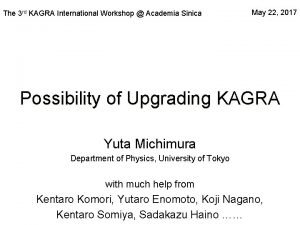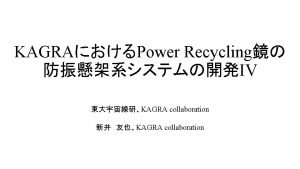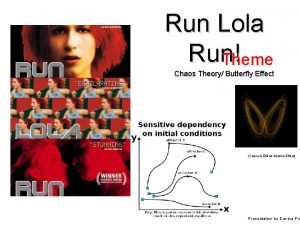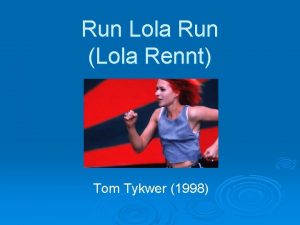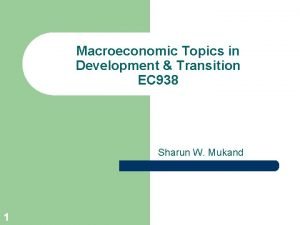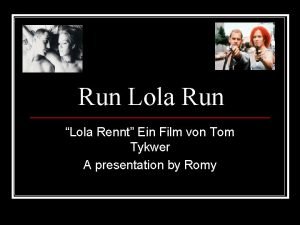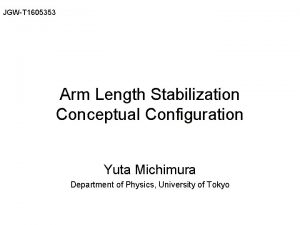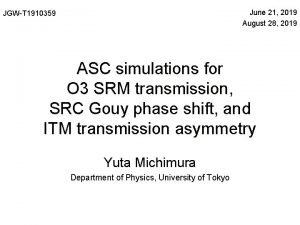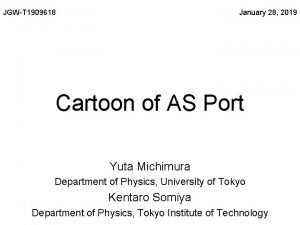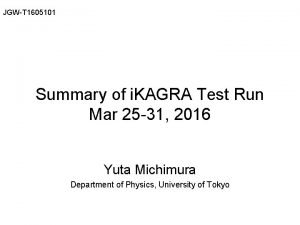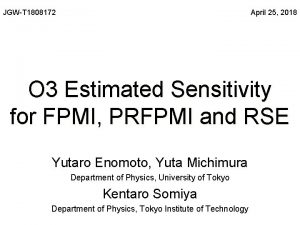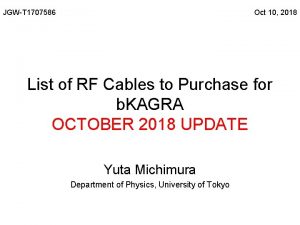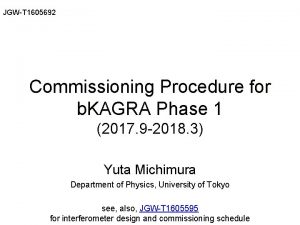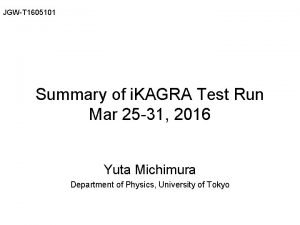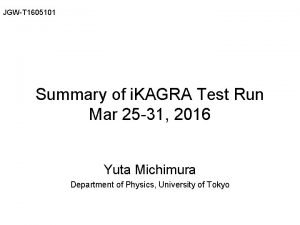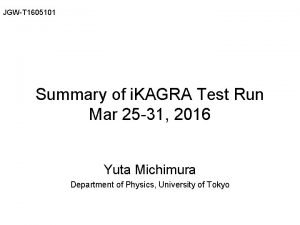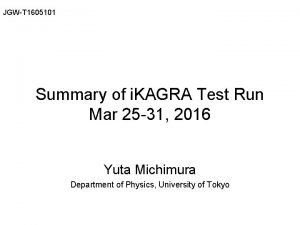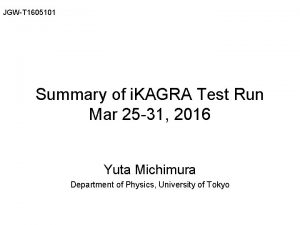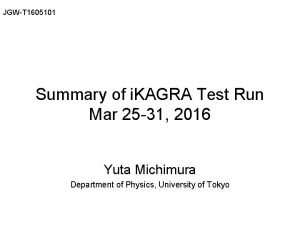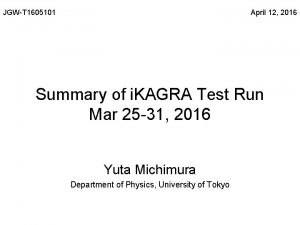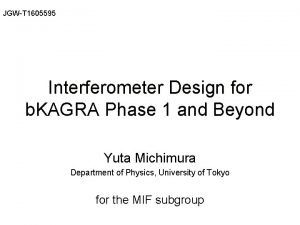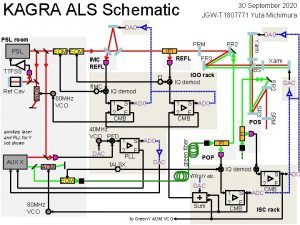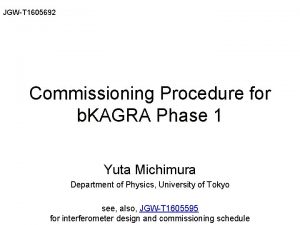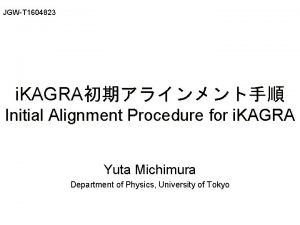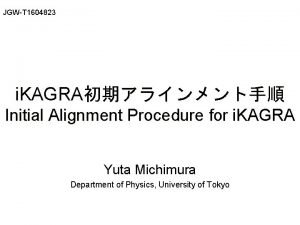JGWT 1605101 Summary of i KAGRA Test Run
















- Slides: 16

JGW-T 1605101 Summary of i. KAGRA Test Run Mar 25 -31, 2016 Yuta Michimura Department of Physics, University of Tokyo

Quick Facts • • 3 km Michelson, mid-fringe lock input power to BS ~ 220 m. W power at detection port (REFL) ~ 8 m. W duration: Mar 25 9: 00 JST - Mar 31 17: 00 JST (from 1142899217 to 1143446417 in GPS time) duty cycle (lock): 85. 2 % (IMC was 94. 4 %) total locked time: 129. 5 hours longest lock: 3. 6 hours (but typically ~ 30 minutes) strain sensitivity: ~3 e-15 /rt. Hz @ 100 Hz (~0. 77 pc for 1. 4 Msun-1. 4 Msun NS-NS inspiral range) Thanks to inputs from Y. Saito, T. Uchiyama, Y. Aso, O. Miyakawa, K. Kokeyama, K. Hayama, Y. Sasaki, M. Nakano, Y. Enomoto, T. Shimoda, etc …… 2

Interferometer Configuration • 3 km Michelson, mid-fringe lock, UGF ~8 Hz • suspended mirrors DC alignment controlled with oplevs IMC round-trip length: 53. 30253(5) m (klog #616) finesse: 540(70) (klog #618) mode matching ratio: 86. 2 % (JGW-G 1605019) (see klog # 991 for servo topology) PMC round-trip length: 0. 4 m (IOO blog 20141209) finesse: 197 (IOO blog 20141209) mode matching ratio: 75 % (IOO blog 20150623) MCe 270 m. W 2 W NPRO PZT loop ~3 k. Hz Laser MCi MCe loop ~30 Hz (cross over) IFI transmissivity: 94 % (JGW-G 1604999) PR 2 MCo ETMY Michelson BS-ETMX length: 2991. 6 m (designed) BS-ETMY length: 2988. 3 m (designed) contrast: ~70 % at best (klog # 1169) beam radii at PR 3 wx = 35. 3(2) mm wy = 37. 5(3) mm (klog # 907) IFI ETMX PR 3 BS RFM network temp loop ~300 m. Hz PZT loop ~30 k. Hz ETM loop ~8 Hz 3

Suspensions and Mirrors • fused silica, room temperature MCi, MCo, MCe Type-C (double pendulum with stacks) x config magnets ETMY 95. 95 mm dia, 29. 5 mm thick Ro. C = 37. 33(9) m (klog #711) ETMX, ETMY (TAMA PRM) PR 3 Type-C (double pendulum without stacks) Type-Bp’ (double pendulum) + config magnets 250 mm dia, 100 mm thick wire dia 100 um for X, 50 um for Y Ro. C = 24. 92 m 100 mm dia, 60 mm thick TM stage was fixed Ro. C = 9 km IM stage has 6 OSEMs reflectivity: 50 % for X, 90 % for Y (probably) MCe MCi Laser PR 2 fixed 2 -inch mirror Ro. C = -3. 0 +/- 0. 2 m PR 2 MCo IFI PR 3 BS (CLIO BS) Type-C (double pendulum without stacks) x config magnets 150 mm dia, 40 mm thick (no wedge) Ro. C = flat ETMX BS 4

Vacuum • central part and both ends were at air (PR 2 -BS was not connected, but covered; klog #1078) ETMY EYA air pressure Yarm 68 Pa Oct 28: last fastening IMC 200 Pa (klog #1020) GVs close to IXA/IYA were closed MCe IYC+IYA 1. 5 Pa Mar 19: pumping IFI to BS area air pressure MCi Laser PR 2 MCo EXA air pressure IFI ETMX PR 3 BS slide based on 160330_Alignment. ppt by Y. Saito IXC+IXA 4. 0 Pa Mar 19: pumping Xarm 1. 6 Pa one year sealed off 5

Calibration • calibration of error signal (optical gain) 2. 3 e 10 counts/m (klog #1169) • calibration of feedback signal (actuator efficiency) 1. 8 e-14 m/counts @ 80 Hz (klog #1169) • calibration lines at 80 Hz and 135 Hz to monitor loop gain rough calib Michelson differential displacement [m] K 1: LSC-REFL_PDA 1_DC_OUT_DQ calibration lines (80 Hz, 135 Hz) ETMX: 2. 6 e-10 m/counts at DC, f 0=0. 94 Hz, Q= 5. 1 ETMY: 0. 94 e-10 m/counts at DC, f 0=0. 92 Hz, Q = 4. 6 combined: 1. 7 e-10 m/counts at DC (sign was wrong) demodulated signal K 1: LSC-LKIN_CAL 1/2_A_REAL/IMAG_OUT_DQ (1 for 80 Hz, 2 for 135 Hz) K 1: LSC-MICH_ERR_CAL_OUT_DQ error signal Michelson optical gain 2. 3 e 10 counts/m Actuator (klog #1340) roughly calibrated in L*h(t) [m] feedback signal K 1: LSC-MICH_OUT_DQ Filter zero at 0. 2, 7 Hz pole at 0. 02, 200 Hz DC gain 100 (notch at 15. 3 Hz) demodulated signal K 1: LSC-LKIN_CAL 1/2_B_REAL/IMAG_OUT_DQ 6 (1 for 80 Hz, 2 for 135 Hz)

Duty Cycle and Lock Duration • duty cycle: 85. 2 % (94. 4 % for IMC) data processing and plot by Y. Sasaki • longest lock: 3. 6 hours (12 hours for IMC) IMC lock duration histogram MICH lock duration histogram (you can see bump at ~30 min) 7

Tidal Drift • X arm length and Y arm length drifts by ~60 um • this caused lock loss every ~30 min because of the saturation of the feedback signal → needs more actuation range measured with 3 -km Michelson prediction calculated by A. Araya JGW-E 1605098 used GOTIC 2 (tidal effect from the Moon and the Sun) plot by K. Hayama et al. (klog #1418) 8

Openloop Gain Drift • MICH openloop gain degraded by almost 80 % (likely by alignment drift) → needs UGF servo (and online calibration) calculation done using K 1: LSC-LKIN_CAL 1_A/B_REAL/IMAG_OUT_DQ by Y. Sasaki & Y. Michimura 9

Inspiral Range • average: 0. 77 pc, standard deviation: 0. 39 pc for 1. 4 Msun-1. 4 Msun NS-NS plot by K. Hayama 10

Noise Budget • likely to be limited by intensity noise of the IMC transmitted beam plot generated with Simulink Noise. Budget by Y. Michimura (klog #1323) 11

Issues in March Test Run • Michelson lock was lost every ~30 minutes • Alignment was adjusted manually ~ once per day • Calibration was done offline • • PMC was re-locked manually GVs close to IXA/IYA was closed PR 2 -BS duct was not connected Some unsafe issues left unaddressed 12

What’s New in April Test Run • Michelson lock was lost every ~30 minutes → improved to ? ? (tidal won’t be a problem this time klog #1446) new actuation efficiency (ETM differential): 2. 6 e-9 m/C at DC(klog #1340), higher UGF (klog #1344), RF lock instead of DC lock (klog #1389), x 10 sensitivity (klog #1389), folded oplev for ETMs to reduce L 2 A (klog #1355) more stable IMC (less feedback to mirrors klog #1388, oplev damping turned off klog #1449) • Alignment was adjusted manually ~ once per day → dither alignment installed for IMC (klog #1474) • Calibration was done offline → UGF servo (klog #1425) and online calibration (klog #1456) • PMC was re-locked manually remote control restored (klog #1351) • GVs close to IXA/IYA was closed opened(klog #1338) • PR 2 -BS duct was not connected • Some unsafe issues left unaddressed partially addressed 13

Calibration for April Test Run • calibration of error signal (optical gain) 5. 3 e 10 counts/m (klog #1455) • calibration of feedback signal (actuator efficiency) 2. 6(1)e-9 m/counts @ DC (klog #1340) • calibration lines at 80 Hz for UGF servo (UGF controlled at 100 Hz) and at 135 Hz for loop gain monitor Michelson differential displacement [m] error signal Michelson optical gain 5. 3 e 10 counts/m K 1: LSC-REFL_PDA 1_RF 17_Q_ERR_DQ calibrated in L*h(t) [nm] online calib Actuator (klog #1340) K 1: LSC-MICH_CTRL_CAL_OUT_DQ calibration lines (80 Hz, 135 Hz) ETMX: 1. 6 e-9 m/counts at DC, f 0=0. 94 Hz, Q= 5. 1 ETMY: 1. 0 e-9 m/counts at DC, f 0=0. 92 Hz, Q = 4. 6 combined: 2. 6 e-9 m/counts at DC UGF servo signal K 1: LSC-UGF_SERVO_OUT_DQ Filter zero at 0. 2, 70 Hz pole at 0. 02, 2000 Hz DC gain 500 UGF servo 14

Updated Noise Budget • not limited by intensity noise of the IMC transmitted beam • could be BS angular noise coupling? plot generated with Simulink Noise. Budget by T. Shimoda (klog #1478) 15

What To Do After April Test Run • evacuate central part and both ends to open all GVs and see optical axis change to investigate alignment change during evacuation • PR 3 height check • oplev stability, noise measurements with fixed mirror • investigate scattering noise from vibration of ducts • what else? 16
